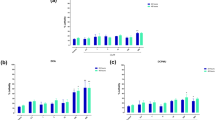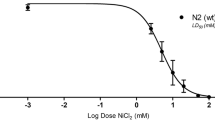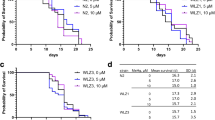Abstract
Previous studies demonstrate a positive correlation between pesticide usage and Parkinson’s disease (PD), which preferentially targets dopaminergic (DAergic) neurons. In order to examine the potential relationship between two common pesticides and specific neurodegeneration, we chronically (24 h) or acutely (30 min) exposed two Caenorhabditis elegans (C. elegans) strains to varying concentrations (LC25, LC50 or LC75) of TouchDown® (TD) as percent active ingredient (glyphosate), or Mancozeb® (MZ) as percent active ingredient (manganese/zinc ethylene-bis-dithiocarbamate). Furthermore, to more precisely model environmental exposure, worms were also exposed to TD for 30 min, followed by 30-min incubation with varying MZ concentrations. Previous data from out lab suggested general neuronal degeneration using the worm strain NW1229 (pan-neuronal//green fluorescent protein (GFP) construct). To determine whether distinct neuronal groups were preferentially affected, we specifically used EG1285 (GABAergic neurons//GFP construct) and BZ555 (DAergic neurons//GFP construct) worms to verify GABAergic and DAergic neurodegeneration, respectively. Results indicated a statistically significant decrease, when compared to controls (CN), in number of green pixels associated with GABAergic neurons in both chronic (*P < 0.05) and acute (*P < 0.05) treatment paradigms. Analysis of the BZ555 worms indicated a statistically significant decrease (*P < 0.05) in number of green pixels associated with DAergic neurons in both treatment paradigms (chronic and acute) when compared to CN. Taken together, our data suggest that exposure to TD and/or MZ promotes neurodegeneration in both GABAergic and DAergic neurons in the model organism C. elegans.




Similar content being viewed by others
References
Arima H, Sobue K, So M, Morishima T, Ando H, Katsuya H (2003) Transient and reversible parkinsonism after acute organophosphate poisoning. J Toxicol Clin Toxicol 41:67–70
Axelrad JC, Howard CV, McLean WG (2003) The effects of acute pesticide exposure on neuroblastoma cells chronically exposed to diazinon. Toxicology 185:67–78
Bahrami F, Yousefpour M, Mehrani H, Golmanesh L, Sadraee SH, Khoshbaten A, Asgari A (2009) Type of cell death and the role of acetylcholinesterase activity in neurotoxicity induced by paraoxon in cultured rat hippocampal neurons. Acta Biol Hung 60:1–13
Barone P (2010) Neurotransmission in Parkinson’s disease: beyond dopamine. Eur J Neurol 17:364–376
Bekris LM, Mata IF, Zabetian CP (2010) The genetics of Parkinson disease. J Geriatr Psychiatry Neurol 23:228–242
Benedetto A, Au C, Avila DS, Milatovic D, Aschner M (2010) Extracellular dopamine potentiates mn-induced oxidative stress, lifespan reduction, and dopaminergic neurodegeneration in a BLI-3-dependent manner in Caenorhabditis elegans. PLoS Genet 6:e1001084
Betarbet R, Sherer T, MacKenzie G, Garcia-Osuna M, Panov AV, Greenamyre JT (2000) Chronic systemic pesticide exposure reproduces features of Parkinson’s disease. Nat Neurosci 3:1301–1306
Betarbet R, Canet-Aviles RM, Sherer TB, Mastroberardino PG, McLendon C, Kim JH, Lund S, Na HM, Taylor G, Bence NF, Kopito R, Seo BB, Yagi T, Yagi A, Klinefelter G, Cookson MR, Greenamyre JT (2006) Intersecting pathways to neurodegeneration in Parkinson’s disease: effects of the pesticide rotenone on DJ-1, alpha-synuclein, and the ubiquitin-proteasome system. Neurobiol Dis 22:404–420
Bhatt MH, Elias MA, Mankodi AK (1999) Acute and reversible parkinsonism due to organophosphate pesticide intoxication: five cases. Neurology 52:1467–1471
Billingslea J (2009) Maneb: notice of receipt of a request to voluntarily cancel pesticide registrations of certain products, U. E. P. Agency edition. Environmental Protection Agency
Binukumar BK, Gill KD (2010) Cellular and molecular mechanisms of dichlorvos neurotoxicity: cholinergic, nonchlolinergic, cell signaling, gene expression and therapeutic aspects. Indian J Exp Biol 48:697–709
Birch M (1993) Toxicological investigation of CP 67573-3. Unpublished report no. 4-70-90, (1970) by Monsanto Corporation, prepared by Younger Laboratories, Inc., O. o. P. US Environmental Protection Agency, Pesticides, and Toxic Substances, edition. Office of Pesticide Programs, US Government Printing Office, Washington, DC
Bonide I (2010) Mancozeb Flowable with zinc concentrate, I. Bonide products, edn. Bonide Products, Inc, Oriskany, NY
Brenner S (1974) The genetics of Caenorhabditis elegans. Genetics 77:71–94
Brown TP, Rumsby PC, Capleton AC, Rushton L, Levy LS (2006) Pesticides and Parkinson’s disease—is there a link? Environ Health Perspect 114:156–164
Chalfie M, White J (1988) The nervous system. In: Wood WB (ed) The nematode Caeorhabditis elegans. Cold Spring Harbor Laboratory Press, Cold Spring Harbor, pp 337–392
Chase DL, Koelle MR (2007) Biogenic amine neurotransmitters in C. elegans. In: Worm book, T. C. e. R. Community edition. doi:10.1895/wormbook.1.132.1, http://www.wormbook.org
Cicchetti F, Lapointe N, Roberge-Tremblay A, Saint-Pierre M, Jimenez L, Ficke BW, Gross RE (2005) Systemic exposure to paraquat and maneb models early Parkinson’s disease in young adult rats. Neurobiol Dis 20:360–371
Cooper J, Bloom F, Roth R (1996) Dopamine. In: Cooper J, Bloom F, Roth R (eds) The neurochemical basis on neuropharmacology. Oxford University Press, New York, pp 293–351
Costello S, Cockburn M, Bronstein J, Zhang X, Ritz B (2009) Parkinson’s disease and residential exposure to maneb and paraquat from agricultural applications in the central valley of California. Am J Epidemiol 169:919–926
Domico LM, Zeevalk GD, Bernard LP, Cooper KR (2006) Acute neurotoxic effects of mancozeb and maneb in mesencephalic neuronal cultures are associated with mitochondrial dysfunction. Neurotoxicology 27:816–825
Domico LM, Cooper KR, Bernard LP, Zeevalk GD (2007) Reactive oxygen species generation by the ethylene-bis-dithiocarbamate (EBDC) fungicide mancozeb and its contribution to neuronal toxicity in mesencephalic cells. Neurotoxicology 28:1079–1091
Donaldson D, Kiely T, Grube A (2004) Pesticides industry sales and usage: 2000 and 2001 market estimates, U. S E. P. Agency edn. United States Environmental Protection Agency, Washington, DC
Fernandez-Cornejo J (2010) Rapid growth in adoption of genetically engineered crops continues in the US, U. S. D. o. Agriculture edition. http://www.ers.usda.gov/Data/BiotechCrops/. United States Department of Agriculture
Ferraz HB, Bertolucci PH, Pereira JS, Lima JG, Andrade LA (1988) Chronic exposure to the fungicide maneb may produce symptoms and signs of CNS manganese intoxication. Neurology 38:550–553
Filipov NM, Sistrunk SC, Coban A, Norwood AB (2005) Peripheral LPS enhances dopaminergic toxicity of the fungicide maneb in a strain-dependent manner in mice. Brain Behav Immun 19:e20
Hozumi I, Hasegawa T, Honda A, Ozawa K, Hayashi Y, Hashimoto K, Yamada M, Koumura A, Sakurai T, Kimura A, Tanaka Y, Satoh M, Inuzuka T (2011) Patterns of levels of biological metals in CSF differ among neurodegenerative diseases. J Neurol Sci 303:95–99
Jiang W, Duysen EG, Hansen H, Shlyakhtenko L, Schopfer LM, Lockridge O (2010) Mice treated with chlorpyrifos or chlorpyrifos oxon have organophosphorylated tubulin in the brain and disrupted microtubule structures, suggesting a role for tubulin in neurotoxicity associated with exposure to organophosphorus agents. Toxicol Sci 115:183–193
Jorgensen EM (ed) (2005) GABA. doi:10.1895/wormbook.1.14.1, http://www.wormbook.org, http://www.wormbook.org
Kiely T, Donaldson D, Grube A (2004) Pesticides industry sales and usage: 2000 and 2001 market estimates (U. S. E. P. Agency edition). Office of Prevention and Toxic Substances, Washington, DC
Kim Y, Kim JM, Kim JW, Yoo CI, Lee CR, Lee JH, Kim HK, Yang SO, Chung HK, Lee DS, Jeon B (2002) Dopamine transporter density is decreased in parkinsonian patients with a history of manganese exposure: what does it mean? Mov Disord 17:568–575
Langston JW (2006) The Parkinson’s complex: parkinsonism is just the tip of the iceberg. Ann Neurol 59:591–596
Lester DB, Rogers TD, Blaha CD (2010) Acetylcholine-dopamine interactions in the pathophysiology and treatment of CNS disorders. CNS Neurosci Ther 16:137–162
Li X, Yin J, Cheng CM, Sun JL, Li Z, Wu YL (2005) Paraquat induces selective dopaminergic nigrostriatal degeneration in aging C57BL/6 mice. Chin Med J (Engl) 118:1357–1361
Manthripragada AD, Costello S, Cockburn MG, Bronstein JM, Ritz B (2010) Paraoxonase 1, agricultural organophosphate exposure, and Parkinson disease. Epidemiology 21:87–94
Meco G, Bonifati V, Vanacore N, Fabrizio E (1994) Parkinsonism after chronic exposure to the fungicide maneb (manganese ethylene-bis-dithiocarbamate). Scand J Work Environ Health 20:301–305
Mounsey RB, Teismann P (2010) Mitochondrial dysfunction in Parkinson’s disease: pathogenesis and neuroprotection. Parkinsons Dis 2011:617472
Negga R, Rudd DA, Davis NS, Justice AN, Hatfield HE, Valente AL, Fields AS, Fitsanakis VA (2011) Exposure to Mn/Zn ethylene-bis-dithiocarbamate and glyphosate pesticides leads to neurodegeneration in Caenorhabditis elegans. Neurotoxicology 32:331–341
Olorunsogo OO, Bababunmi EA, Bassir O (1979) Effect of glyphosate on rat liver mitochondria in vivo. Bull Environ Contam Toxicol 22:357–364
Peixoto F (2005) Comparative effects of the Roundup and glyphosate on mitochondrial oxidative phosphorylation. Chemosphere 61:1115
Peterson RT, Nass R, Boyd WA, Freedman JH, Dong K, Narahashi T (2008) Use of non-mammalian alternative models for neurotoxicological study. Neurotoxicology 29:546–555
Powles S, Preston C, Bryan I, Jutsun A (1997) Herbicde resistance: impact and management. Adv Agron 58:57–93
Racette BA, Tabbal SD, Jennings D, Good L, Perlmutter JS, Evanoff B (2005) Prevalence of parkinsonism and relationship to exposure in a large sample of Alabama welders. Neurology 64:230–235
Rand JB, Nonet ML (1997) Appendix 2: neurotransmitter assignments for specific neurons. In: Riddle DL, Blumenthal T, Meyer BJ, Priess JR (eds) C. elegans II. Cold Spring Harbor Laboratory Press, Plainview, New York
Randall C, Hock W, Crow E, Hudak-Wise C, Kasai J (2008a) Pesticide application procedures. In: National pesticide applicator certification core manual. National Association of State Departments of Agriculture Research Foundation, Washington, DC, pp 163–176
Randall C, Hock W, Crow E, Hudak-Wise C, Kasai J (2008b) Planning the pesticide application. In: National pesticide applicator certification core manual. National Association of State Departments of Agriculture Research Foundation, Washington, DC, pp 149–162
Samara C, Rohde CB, Gilleland CL, Norton S, Haggarty SJ, Yanik MF (2010) Large-scale in vivo femtosecond laser neurosurgery screen reveals small-molecule enhancer of regeneration. Proc Natl Acad Sci U S A 107:18342–18347
Saravanan KS, Sindhu KM, Mohanakumar KP (2005) Acute intranigral infusion of rotenone in rats causes progressive biochemical lesions in the striatum similar to Parkinson’s disease. Brain Res 1049:147–155
Senti G, Swoboda P (2008) Distinct isoforms of the RFX transcription factor DAF-19 regulate ciliogenesis and maintenance of synaptic activity. Mol Biol Cell 19:5517–5528
Slotkin TA, Levin ED, Seidler FJ (2009) Developmental neurotoxicity of parathion: progressive effects on serotonergic systems in adolescence and adulthood. Neurotoxicol Teratol 31:11–17
Syngenta (2010) TouchDown Hi Tech. In: Product label (Syngenta edition) Syngenta Crop Protection, Greensboro, NC
Tanner CM (2010) Advances in environmental epidemiology. Mov Disord 25(Suppl 1):58–62
Thiruchelvam M, Brockel BJ, Richfield EK, Baggs RB, Cory-Slechta DA (2000) Potentiated and preferential effects of combined paraquat and maneb on nigrostriatal dopamine systems: environmental risk factors for Parkinson’s disease? Brain Res 873:225–234
Thomas JH, Lockery S (1999) Neurobiology. In: Hope IA (ed) C. elegans: a practical approach. Oxford University Press, New York
Tierney KB, Ross PS, Jarrard HE, Delaney KR, Kennedy CJ (2006) Changes in juvenile coho salmon electro-olfactogram during and after short-term exposure to current-use pesticides. Environ Toxicol Chem 25:2809–2817
Tierney KB, Singh CR, Ross PS, Kennedy CJ (2007) Relating olfactory neurotoxicity to altered olfactory-mediated behaviors in rainbow trout exposed to three currently-used pesticides. Aquat Toxicol 81:55–64
USGS (2002) Pesticide national synthesis project: glyphosate usage (U. S. D. o. t. Interior and U. S. G. Survey, editions), United States Geological Survey
Wang Y, Zhang QJ, Liu J, Ali U, Gui ZH, Hui YP, Chen L, Wang T (2010) Changes in firing rate and pattern of GABAergic neurons in subregions of the substantia nigra pars reticulata in rat models of Parkinson’s disease. Brain Res 1324:54–63
Weintraub D, Comella CL, Horn S (2008) Parkinson’s disease—Part 1: pathophysiology, symptoms, burden, diagnosis, and assessment. Am J Manag Care 14:S40–S48
Willis AW, Evanoff BA, Lian M, Galarza A, Wegrzyn A, Schootman M, Racette BA (2010) Metal emissions and urban incident Parkinson disease: a community health study of Medicare beneficiaries by using geographic information systems. Am J Epidemiol 172:1357–1363
Woodburn AT (2000) Glyphosate: production, pricing and use worldwide. Pest Manag Sci 56:309–312
Yamamoto N, Soghomonian JJ (2009) Metabotropic glutamate mGluR5 receptor blockade opposes abnormal involuntary movements and the increases in glutamic acid decarboxylase mRNA levels induced by l-DOPA in striatal neurons of 6-hydroxydopamine-lesioned rats. Neuroscience 163:1171–1180
Zhang J, Fitsanakis VA, Gu G, Jing D, Ao M, Amarnath V, Montine TJ (2003) Manganese ethylene-bis-dithiocarbamate and selective dopaminergic neurodegeneration in rat: a link through mitochondrial dysfunction. J Neurochem 84:336–346
Zhu J, Chu CT (2010) Mitochondrial dysfunction in Parkinson’s disease. J Alzheimers Dis 20(Suppl 2):S325–S334
Acknowledgment
This work was supported by the National Institute of Environmental Health Sciences [R15 ES015628 to VF] and by the Appalachian College Association Colonel Lee B. Ledford Endowment Fund [to RN, AJ and VF].
Author information
Authors and Affiliations
Corresponding author
Rights and permissions
About this article
Cite this article
Negga, R., Stuart, J.A., Machen, M.L. et al. Exposure to Glyphosate- and/or Mn/Zn-Ethylene-bis-Dithiocarbamate-Containing Pesticides Leads to Degeneration of γ-Aminobutyric Acid and Dopamine Neurons in Caenorhabditis elegans . Neurotox Res 21, 281–290 (2012). https://doi.org/10.1007/s12640-011-9274-7
Received:
Revised:
Accepted:
Published:
Issue Date:
DOI: https://doi.org/10.1007/s12640-011-9274-7




